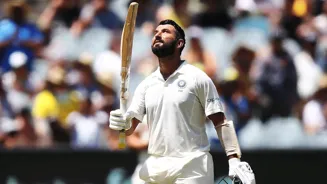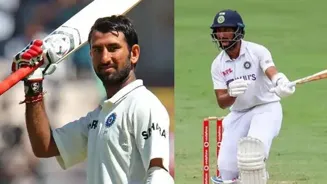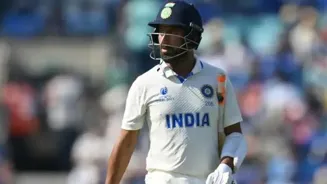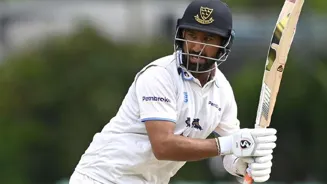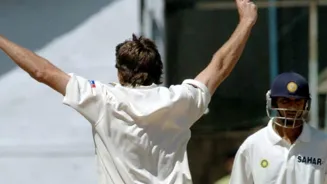New Delhi: A rare breed in modern-day cricket and possibly the last of India’s Test purists, Cheteshwar Pujara announced his retirement from all forms
of Indian cricket on Sunday. The 37-year-old was the backbone of India’s Test batting line-up for over a decade and one of the most reliable no. 3s that the country has ever produced in the longest format.
In an era where the razzmatazz of T20 cricket had started to undermine the value of Tests, Pujara rose in stature as one of the custodians of cricket’s oldest format, making millions fall in love with his batting. His style, a mix of grind, heart and patience, helped him become one of India’s most admired Test batters, who entertained fans in his own way.
Pujara remained India’s most reliable Test batter for the majority of his career, playing key roles in some of the team’s most famous victories both home and away. He was one of the reasons behind the team’s undisputed dominance at home and made batting look comfortable against the most fearsome bowling attacks across most treacherous conditions in red-ball cricket.
From The Wall regen to India’s very own Pujara
Calling him India’s Wall 2.0 after Rahul Dravid would be a fair assessment, but Pujara was a lot more than just that. When he first broke onto the scene for India as a youngster in 2010, Pujara’s batting style, his temperament and his defensive skills earned him a straight comparison with the legendary Rahul Dravid.
In his debut Test against Australia in Bengaluru, Pujara replaced Dravid at no.3 in the 2nd innings and scored a well-compiled 72, an innings showcasing his class and composure despite the pressure of the big stage at a young age. He played two more Tests after that, but was made to wait for regular opportunities.
He could cement his position in the Indian Test team only after Dravid and VVS Laxman hung up their boots in 2012, freeing up spots in the top 4. Pujara seamlessly filled in for Dravid at no.3 and ended up making the spot his own. A terrific 159 against New Zealand in Hyderabad in his comeback Test, followed by his maiden double ton against England in Ahmedabad in his next series set Pujara’s juggernaut rolling.
For many, he was The Wall regen, quite similar in style and technique to his predecessor Dravid, one of Test cricket’s greatest batters. But while he had Dravid’s qualities and held the fort at no.3 for over a decade for India in Tests, Pujara carved out his own niche. While he was defensively astute, he could accelerate equally well for a big knock after grinding out a half-century.
But like Dravid, conditions went out of the game when Pujara walked out in the middle, as his impeccable technique helped him score runs everywhere. Pujara bailed India out of trouble on several occasions in Tests and anchored the team to numerous victories while being the silent warrior for the team in the whites.
Colombo to Gabba – the Pujara impact
One of the strongest pillars in India’s Test batting line-up even in the era of peak Virat Kohli, Pujara played numerous defining knocks in his career. He slammed a brilliant 153, batting for nearly six hours in the second innings of Johannesburg Test to help India secure a draw. In the Colombo Test against Sri Lanka in 2015, Pujara once again stood in the middle for a long period.
He opened the batting and returned with a gritty 145 off 289 balls. In 2018, on a spicy track in Southampton, Pujara’s tenacious 132, his maiden Test ton in England, turned heads. The world witnessed the best of the man in Australia during the 2018-19 Border-Gavaskar Trophy, where he smashed centuries in Adelaide, Melbourne and Sydney to help India pull off a memorable maiden Test series victory Down Under.
Two years later, Pujara once again stood like a rock for India during the 2021-22 Border-Gavaskar Trophy to help the visitors earn their second successive Test series victory in Australia. Pujara scored 271 runs in the series, but his most valuable knock came in India’s famous heist at the Gabba, where he wore down the Aussie pace attack with a defiant 211-ball 56.
Constantly targeted with bodyline bowling, Pujara coped with multiple blows to his body and took severe bruises, but stood tall to help India pull off one of their greatest overseas Test victories in recent times. His Gabba knock perfectly embodied the cricketer that Pujara was – gritty and resilient.
Overall, he walks away as India’s eighth-highest run-getter in Test cricket with 7195 runs in 103 matches, averaging over 43, with 19 tons and 35 fifties. He scored 3839 runs at home, averaging over 52, showcasing his impact in India’s unparalleled Test dominance at home from 2013 to 2024, a period where they went unbeaten in 18 Test series.
